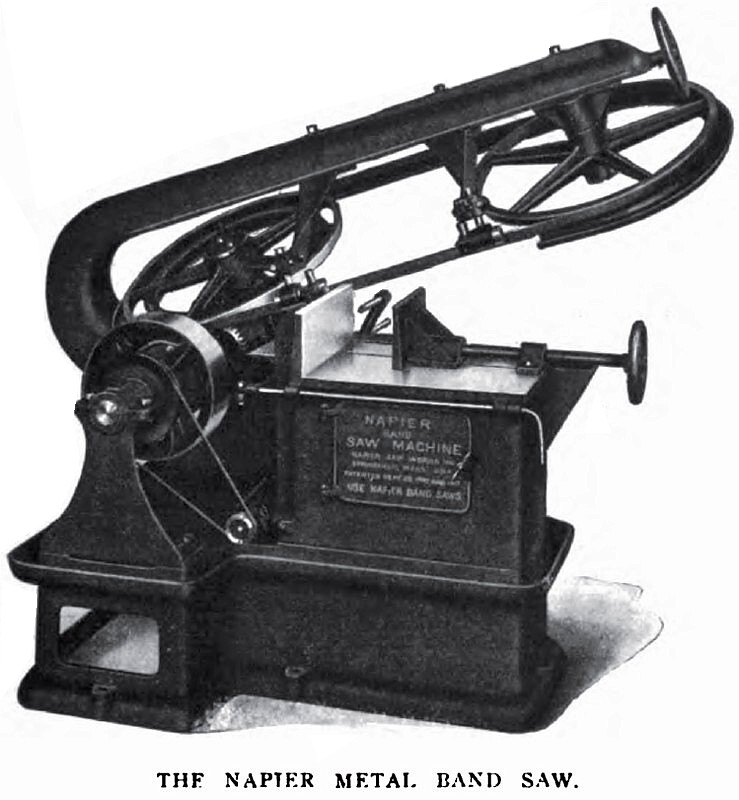|
Title: |
1919 Article-Napier Saw Works Inc., Metalworking Band Saw |
|
Source: |
The Metal Industry, V17, Jan 1919, pg. 41 |
|
Insert Date: |
1/24/2013 1:33:22 PM |
NAPIER METAL BAND SAW MACHINE
The sawing of metals is performed in ordinary practice by three different types of saw: The circular saw with its wide blade which wastes metal, and by the hack saw machine which, due to the reciprocating stroke, is far from being an efficient tool, and by the metal band saw which overcomes the main objections to the two types of tools previously mentioned, and, in addition, has the advantage of being a machine which cuts fast and straight, and with a low maintenance cost.
The manufacturers of the machine shown in the cut, the Napier Saw Works, Inc., Springfield, Mass, say that: "The Napier band saw machine is the latest and best band saw machine. It is the ideal continuous stroke hack saw put into actual operation in a practical machine tool. The designer of this machine is correct in principle, and around the principle governing this machine there has been designed a rigid and durable tool which will give a lifetime of hard, continuous service in any shop. The Napier band saw machine is designed to carry a 1-inch band. The width of the band assures straight cutting with proper feeding weights and speeds, with practically no breakage of the band saws. The band saws on this machine wear out before they break. The head of this machine which rotates about the driving shaft is perfectly balanced so that there is a constant feeding weight from the start to finish of any cut which can be made on the machine. This refinement in the design permits the band saw to be operated at high efficiency at all times, and is largely responsible for the success, which this machine has attained.
"Special attention has also been given to the design of the guides so that there is no wear on the saw or breakage caused by loss of adjustment or other cause.
"The machine consists of very few principal parts. There is the base in which the tank containing the lubricant for the saw is placed. This base carries the housings for the main shaft of the machine and the cabinet carries the vise. On the main shaft of the machine is mounted the driving pulley, the clutch, the pinion driving gear, and the bearing around which the tilting head rotates. The tilting head carries two wheels, the truss arms and guides, and the spring is placed in such a position that the feeding weight is constant from the start to finish of any cut. The tension in this spring may be regulated by a hand wheel, thus varying the feeding weight. The cutting band is lower than the running band, thus making it possible to cut off any length required. By means of the guides on the truss arms, the band saw blade is directed so that its travel between the guides is absolutely vertical, thus assuring of straight cutting and saving of material. These guides once set are in perfect adjustment for any saw, which may be placed on a machine.
The Napier saw machine is simple to operate. Lock the work in the vise, adjust the saw to cut toward the rear of machine, start the saw, adjust the flow of the cutting compound, release the tilting head and lower it gently until the saw engage the work and the saw will do the rest.
“Quality” metal band saws are furnished with the Napier saw machine. These saws have now been so perfected that by their use the low cost of metal band sawing and large production makes them a necessity in any factory. Quality metal band saws, on a Napier band saw wear out before they break.
"The Napier band saw is a general purpose machine which will cut metal at good rates of speed at low costs for saw blades and at a low maintenance rate on the machine. It is a tool which is especially appreciated in the tool room of any general manufacturing concern where there are all varieties and sizes of material to be cut." |
|
 1919 Napier Saw Works Inc., Metalworking Band Saw
1919 Napier Saw Works Inc., Metalworking Band Saw
|
|